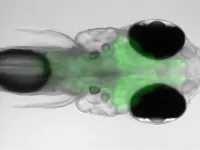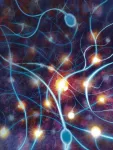(Press-News.org) MIAMI, FLORIDA (EMBARGOED UNTIL FEB. 1, 2024, AT 2 P.M. ET) – New research from Sylvester Comprehensive Cancer Center at the University of Miami Miller School of Medicine and collaborating organizations has identified a next-generation BTK degrader that could help overcome treatment resistance in chronic lymphocytic leukemia (CLL) and related blood cancers.
Their findings, published Feb. 2 in the journal Science, could offer a therapeutic option for CLL patients whose tumors become drug-resistant or are unresponsive to frontline treatment.
“This new compound not only inhibits the cellular molecule BTK, but goes further by taking aim at the target and destroying it,” explained Justin Taylor, M.D., Sylvester hematologist-researcher and the study’s senior author. “It’s a new and exciting drug class called BTK degraders.”
CLL is an incurable cancer of the blood and bone marrow that affects about 20,000 people yearly in the U.S. and accounts for roughly one-fourth of new leukemia cases, according to the American Cancer Society. It mainly affects older adults, with the average age at diagnosis being 70.
Patients diagnosed with CLL are often prescribed targeted drugs knowns as BTK inhibitors that can shrink tumors, ease symptoms and extend lifespans. But some patients develop drug resistance, thereby limiting their therapeutic options.
Currently approved drugs like ibrutinib work by inactivating the cellular molecule called BTK (Bruton’s tyrosine kinase). Ibrutinib and other approved inhibitors don’t destroy their targets. Instead, they bind to them and modulate activity.
For example, ibrutinib and other inhibitors bind to the BTK enzyme that acts to keep B cells alive in leukemia. The drugs quell BTK activity, leading to B-cell death in CLL and other blood malignancies.
For this study, Taylor and colleagues, including first author Skye Montoya, a graduate student in his research lab, Omar Abdel-Wahab, M.D., from Memorial Sloan Kettering Cancer Center, and other collaborators assessed the new compound in laboratory studies and a phase 1 clinical trial involving patients with tumors that had become drug-resistant or were unresponsive to therapy. Developed by Nurix Therapeutics, the compound, called NX-2127, is constructed with two modules – one that binds to BTK and another that degrades and eliminates it. Thus, the term BTK degrader.
The researchers reported that NX-2127 efficiently destroyed its cellular targets in both petri dishes and patient cells. “More specifically, this compound destroyed BTK cells in tumors resistant to currently used BTK inhibitors, while shrinking tumors in 11 of 14 CLL patients participating in our study,” said Abdel-Wahab, who was co-corresponding author with Taylor.
One patient, in particular, had an impressive response to this BTK degrader, Taylor and Abdel-Wahab noted. The elderly man had been on pirtobrutinib for two years, but became resistant to it as well as other therapies, leaving him with no other conventional options.
However, while taking NX-2127 during the trial, his symptoms and quality of life improved to where he no longer needed transfusions for anemia, they said.
Further study analysis
Although this study had a September 2022 data cutoff for the Science publication, the researchers provided an update this past December at the American Society of Hematology meeting. Overall, 41% of CLL patients responded to NX-2127 and the elderly man was still responding favorably to the drug.
Additionally, the research showed that drug resistance can occur when BTK acquires mutations that give it an entirely new function. These mutations cause BTK to operate as a “scaffold” that recruits other cellular molecules to keep B cells alive.
Most importantly, NX-2127 appears to overcome resistance caused by virtually all of the BTK mutations identified to cause resistance to available BTK inhibitors.
Taylor believes that BTK degraders have the potential to treat other B-cell malignancies or even autoimmune conditions such as multiple sclerosis. He and his colleagues, including Alvaro Alencar, M.D., Sylvester hematologist-researcher and contributing study author, are now enrolling patients in another study testing a more potent and selective BTK degrader, NX-5948, also from Nurix.
“CLL is an incurable disease, but with treatments like BTK inhibitors and these promising new BTK degraders, we have more ways to alleviate symptoms and get patients back to their normal everyday routines,” Montoya said. “The future looks brighter for them.”
about this study on the InventUM blog and follow @SylvesterCancer on X for the latest in cancer research and care.
# # #
Article title: Kinase Impaired BTK Mutations Are Susceptible to Clinical Stage BTK and IKZF1/3 Degrader nX-2127.
Authors: The complete list of authors is noted in the paper.
Funding: Many of the participating authors are supported by funding sources listed in the paper.
Disclosures: The authors made numerous disclosures that are included in the paper.
# # #
END
*Embargoed until 14:00 US Eastern / 19:00 UK GMT / 20:00 Europe CET – Thursday 1 February*
Governments and businesses are relying on dangerous amounts of future removal of carbon dioxide (CO2) from the atmosphere, instead of more rapidly reducing emissions and phasing out fossil fuels. This problem is partly due to an incomplete picture1 of the damaging consequences of carbon dioxide removal for people, food security and natural ecosystems, according to new research published in Science.
The paper finds that the carbon dioxide removal potential currently reported by the UN ...
A study published in Science on Feb. 1 reported a comprehensive database of single-neuron projectomes consisting of over 10,000 mouse hippocampal neurons, thus revealing the spatial connectivity patterns of mouse hippocampal neurons at the mesoscopic level.
The study was conducted by teams from the Center for Excellence in Brain Science and Intelligence Technology (CEBSIT), the Institute of Neuroscience of the Chinese Academy of Sciences (CAS), the HUST-Suzhou Institute for Brainsmatics, Hainan University, the Kunming Institute of Zoology of CAS, Lingang Laboratory, and the Shanghai Center for ...
New research published today in the journal Science has concluded that eradicating animals on the basis that they are not native in order to protect plant species, can be a flawed practice costing millions of dollars, and resulting in the slaughter of millions of healthy wild animals.
Introduced large herbivores, or megafauna, are claimed to have distinct and harmful ecological impacts, including damaging sensitive plants and habitats, reducing native plant diversity, and facilitating introduced plants. However, up to now these impacts have been studied without comparison to a proper ...
INDIANAPOLIS—An Indiana University School of Medicine surgeon-scientist is leading a multi-institutional grant investigating the role of the sinus microbiome in chronic rhinosinusitis, an inflammatory disease that causes the lining of the sinuses to swell. The research team will study biospecimens from human sinus surgery patients in the lab and examine how bacteria in the microbiome shape the disease process and might offer novel therapeutic strategies.
Vijay Ramakrishnan, MD, professor of otolaryngology—head ...
LOS ANGELES – February 1, 2024 – Stand Up To Cancer® (SU2C) today announced changes to its Scientific Advisory Committee (SAC), which oversees SU2C’s scientific research.
Composed of cancer research leaders from academic, government, industry, and advocacy fields, SU2C’s SAC sets direction for research initiatives, reviews proposals for new grant awards, and conducts rigorous oversight of all active grants in the SU2C research portfolio in collaboration with SU2C’s president and CEO Julian Adams, Ph.D.
World renowned cancer researcher and Nobel laureate Phillip A. Sharp, Ph.D., who has chaired the SAC since SU2C launched in ...
Philadelphia, February 1, 2024 – New findings in The American Journal of Pathology, published by Elsevier, report that a class of small RNAs (microRNAs), microRNA-29, can restore normal skin structure rather than producing a wound closure by a connective tissue (scar). Any improvement of normal skin repair would benefit many patients affected by large-area or deep wounds prone to dysfunctional scarring.
Because the burden of non-healing wounds is so significant, it is sometimes called a “silent pandemic.” Worldwide, costs associated with wound care are expected to ...
EDMONTON — New research shows an innovative education program is helping to address Alberta’s rural doctor shortage by making it more likely medical students will set up a rural family practice after graduation.
The University of Alberta was one of the first medical schools in Canada to set up its Rural Integrated Community Clerkship program back in 2007. It sends up to 25 third-year students for 10-month intensive work experiences with a single or small number of teaching physicians.
Instead of rotating to a new specialty placement every four to six weeks as in an urban ...
All animals need to regulate their body temperature and cannot survive for long if it gets too high or too low. Warm-blooded organisms like humans have various ways to do this. They release heat by sweating or expanding the blood vessels in their skin, while shivering or burning fat in their brown adipose tissue has the opposite effect.
Cold-blooded animals such as the zebrafish, by contrast, cannot do any of these, so they have a different strategy. They look for places nearby that are at their “comfortable temperature,” just like how we might go out into the sun when we feel chilly or seek out some shade once it gets too ...
While newly approved drugs for Alzheimer’s show some promise for slowing the memory-robbing disease, the current treatments fall far short of being effective at regaining memory. What is needed are more treatment options targeted to restore memory, said Buck Assistant Professor Tara Tracy, PhD, the senior author of a study that proposes an alternate strategy for reversing the memory problems that accompany Alzheimer’s disease and related dementias.
Since most current research on potential treatments for Alzheimer’s focuses on reducing the toxic proteins, such as tau and amyloid beta, that accumulate in ...
(Boston)—One of the major challenges in cancer research and clinical care is understanding the molecular basis for therapeutic resistance as a major cause of long term treatment failures. In cases of melanoma, the main targeted therapeutic strategy is directed against the mitogen-activated protein kinase (MAPK) pathway. Unfortunately, in the vast majority of these patients, resistance to MAPK inhibitor therapies develops within one year of treatment.
In a new study from Boston University Chobanian & Avedisian School of Medicine, ...





